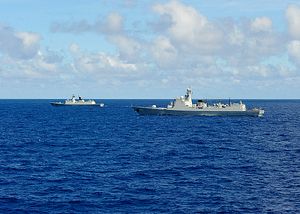In the most recent days, China released a series of announcements involving China’s military operations in the South China Sea and Western Pacific.
On March 23, the People’s Liberation Army Navy (PLAN) told China’s state TV station, CCTV, that it will conduct combat exercises in the South China Sea in the coming days, without specifying the exact time or location.
The PLAN’s staff department claimed that the training is “a routine part of the Navy’s annual training plan and is intended to boost the troops’ combat capability.”
Although the staff department added that the training “doesn’t target any particular country,” the announcement came on the same day the U.S. warship USS Mustin passed within 12 nautical miles of an artificial island built by China in the South China Sea.
According to Reuters’ exclusive report, USS Mustin “traveled close to Mischief Reef in the Spratly Islands and carried out maneuvering operations.” A spokeswoman for U.S. Pacific Fleet added: “We conduct routine and regular freedom of navigation operations, as we have done in the past and will continue to do in the future.”
This “freedom of navigation operation” instantly triggered China’s harsh condemnation.
Also on March 23, China’s Defense Ministry released a strongly worded statement, in which spokesperson Ren Guoqiang referred to this U.S. operation as a “serious political and military provocation.”
Claiming that “China resolutely opposes such actions,” Ren warned the United States that such actions “could lead to misjudgment and even accidents” and “would only drive the Chinese military to continue to improve its defense capabilities.”
He also revealed that two Chinese vessels had identified USS Mustin and warned it off.
On the next day, China’s Foreign Ministry posted another lengthy statement on its website, specifying that USS Mustin had entered into “the neighboring waters of relevant islands and reefs of China’s Nansha [Spratly] Islands.”
Fully in line with Ren’s stance, Chinese Foreign Ministry spokesperson Hua Chunying accused the United States of a laundry list of wrongdoings, including violating Chinese law and relevant international law, infringing upon China’s sovereignty, undermining peace, security, and order, putting in jeopardy the facilities and personnel on the Chinese islands, and creating a serious political and military provocation.
“The Chinese side will continue to take all necessary measures to defend its national sovereignty and security and safeguard peace and stability in the South China Sea,” Hua emphasized.
Soon after, on March 25, the PLA Air Force (PLAAF) suddenly announced that it had “recently conducted a high-sea training mission in the West Pacific and a joint combat patrol mission in the South China Sea.”
Without revealing when the exercises took place, Shen Jinke, spokesperson for the PLAAF, said one team, including H-6K bombers and Su-30 fighters, conducted a real combat training mission in the West Pacific via the Miyako Strait — a channel located between two Japanese islands and close to Taiwan — and another team, including H-6K bombers and Su-35 fighter jets, carried out a joint combat patrol mission in the South China Sea.
Notably, the tone of the PLA Air Force’s announcement was significantly stronger than that of the PLA Navy.
The PLAAF repeatedly emphasized in the announcement that such air drills are the best preparation for war and noted that Chinese pilots have the spirit to die for a war.
Days before the U.S. warship entered the disputed South China Sea area, military tensions between China and the United States had already built up.
On March 16, U.S. President Donald Trump signed the Taiwan Travel Act, a law that “encourages visits between officials of the United States and Taiwan at all levels.” China’s Foreign Ministry immediately lodged a formal protest against this act.
The Global Times, one of China’s most aggressive state-run newspapers, published an editorial on March 21, urging the PLA to “send military planes and warships across the Taiwan Strait’s middle line.”
Earlier in December last year, during an embassy event in the United States, a Chinese diplomat had already sent a threatening message publicly, saying that “The day that a U.S. warship arrives in Kaohsiung [a port city in Taiwan], is the day that our People’s Liberation Army unites Taiwan with military force.”
Thus, the PLA’s latest actions were not only aimed at the single operation by USS Mustin, but were a harsh reply to a series of what China views as recent “provocations” by the United States.

































